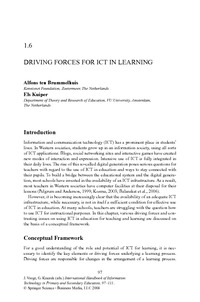Driving Forces for ICT in LearningAlfons ten Brummelhuis, Els Kuiper
Zu finden in: International Handbook of Information Technology in Primary and Secondary Education (Seite 97 bis 111), 2009
|
 |
 Diese Seite wurde seit 10 Jahren inhaltlich nicht mehr aktualisiert.
Unter Umständen ist sie nicht mehr aktuell.
Diese Seite wurde seit 10 Jahren inhaltlich nicht mehr aktualisiert.
Unter Umständen ist sie nicht mehr aktuell.
 Zusammenfassungen
Zusammenfassungen
 Educational change has some reason for taking place. Those reasons are driving forces. Based on a conceptual framework representing the key elements of learning process, this chapter discusses four driving forces for the use of ICT in learning: the teacher, the learner, the learning content and the learning materials. A learning process is seen as the result of both structural conditions (of content and materials) and individual characteristics (of teacher and learner). We argue that the dominance of each driving force can be seen as an instructional paradigm for learning. In order to illustrate the mutual influence and dependence of the driving forces, we elaborate an example of the way driving forces interact. In a final section, we discuss some major implications derived from the various paradigms of ICT in learning and the controversies teachers face when integrating ICT in classroom practice: technology push versus educational pull, and the necessity of leadership and personal entrepreneurship.
Educational change has some reason for taking place. Those reasons are driving forces. Based on a conceptual framework representing the key elements of learning process, this chapter discusses four driving forces for the use of ICT in learning: the teacher, the learner, the learning content and the learning materials. A learning process is seen as the result of both structural conditions (of content and materials) and individual characteristics (of teacher and learner). We argue that the dominance of each driving force can be seen as an instructional paradigm for learning. In order to illustrate the mutual influence and dependence of the driving forces, we elaborate an example of the way driving forces interact. In a final section, we discuss some major implications derived from the various paradigms of ICT in learning and the controversies teachers face when integrating ICT in classroom practice: technology push versus educational pull, and the necessity of leadership and personal entrepreneurship. Dieses Kapitel erwähnt ...
Dieses Kapitel erwähnt ...
 Dieses Kapitel erwähnt vermutlich nicht ...
Dieses Kapitel erwähnt vermutlich nicht ... 
 Nicht erwähnte Begriffe | Bildung, Kinder, Schule, Unterricht |
 Tagcloud
Tagcloud
 Zitationsgraph (Beta-Test mit vis.js)
Zitationsgraph (Beta-Test mit vis.js)
 1 Erwähnungen
1 Erwähnungen 
- Digital Media Adoption in Schools - Bottom-Up, Top-Down, Complementary or Optional? (Dominik Petko, Nives Egger, Andrea Cantieni, Barbara Wespi) (2015)


 Anderswo finden
Anderswo finden
 Volltext dieses Dokuments
Volltext dieses Dokuments
 |  Driving Forces for ICT in Learning: Artikel als Volltext bei Springerlink ( Driving Forces for ICT in Learning: Artikel als Volltext bei Springerlink ( : :  , 144 kByte; , 144 kByte;  : :  2020-11-28) 2020-11-28) |
 Anderswo suchen
Anderswo suchen 
 Beat und dieses Kapitel
Beat und dieses Kapitel
Beat hat Dieses Kapitel während seiner Zeit am Institut für Medien und Schule (IMS) ins Biblionetz aufgenommen. Beat besitzt kein physisches, aber ein digitales Exemplar. Eine digitale Version ist auf dem Internet verfügbar (s.o.). Aufgrund der wenigen Einträge im Biblionetz scheint er es nicht wirklich gelesen zu haben. Es gibt bisher auch nur wenige Objekte im Biblionetz, die dieses Werk zitieren.









 LehrerIn
LehrerIn Lernen
Lernen
 Biblionetz-History
Biblionetz-History